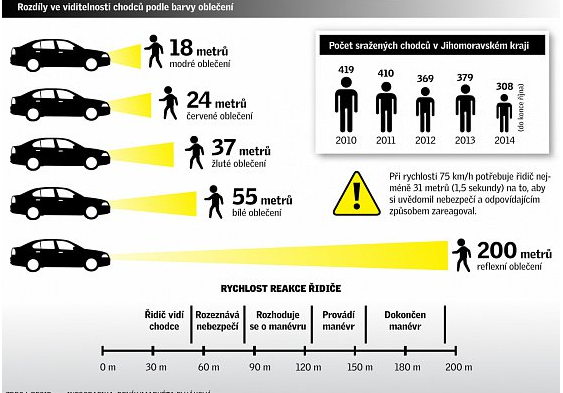Every year hundreds of pedestrians hit cars on South Moravian roads. This year, by the end of October alone, the police have registered over three hundred such cases. Fourteen people died in accidents.
This number is likely to grow by the end of the year, as winter months are the riskiest for pedestrians on the road throughout the year. “Statistics clearly show that there is an increased number of pedestrian clashes in winter. This is most evident in fatal accidents, “said Pavel Cizek, the regional coordinator of Besip for the South Moravian Region.
The increase in pedestrian accidents is due to reduced visibility in winter due to early dimming and dimness in the morning. “The combination of darkness and dusk with fog or rain makes the sighting conditions worse,” Cizek said. He added that pedestrians often contribute poor clothing to poor visibility.
For example, this year the man who crossed the main route in Brno-Svitavy paid for it. A passing driver of a man in dark clothes without reflective material elements did not register in time and knocked him down. The wounded man escaped only a slight wound.
The right choice of clothing can save lives for pedestrians on poorly lit roads. The driver recognizes a man in blue clothes only when he is about eighteen meters away. Much better visibility is in white or yellow garments, which reaches up to fifty meters.
Reflective vests or belts are the most effective means of improving visibility. “The highest quality reflective elements increase visibility up to two hundred meters. After seeing a pedestrian, the drivers have a longer time to react and thus avoid a clash, ”said police spokesman Pavel Svab.
However, poor visibility is not the only reason for caution on winter roads. “Drivers must also count on a longer stopping distance on wet, icy or snowy roads,” Swab emphasized.
In his opinion, drivers often underestimate the longer stopping distance in winter and also forget that there is a significant difference in the visibility of pedestrians on the road using the main beam and dipped beam. In the long-range, the surveillance distance is one hundred meters, while driving with dipped beams the distance is reduced by half.
Caution is needed not only for drivers but also for pedestrians. “They do not realize that they cannot move in the same way as in the summer months. Not rushing in winter pays off, “Cizek said.
About a third of all pedestrian accidents happen at crossings. According to police, people underestimate the risks and switch to red or enter the crossing directly in front of an oncoming car. “Sometimes people don’t look to the right or left and rely on them to take precedence over the transition. Sometimes I can just brake, “complained the driver Michal Benes.
Earphones are also dangerous. The pedestrian does not perceive noises from the street, such as the noise of an approaching car, the ambulance siren or the bell of a tram.
Police are trying to point out irresponsible behavior at various preventive actions. At the end of October, for example, they organized a meeting See us! in Bučovice in the Vyskov region or Firefly in Moutnice in the Brno region. Participants learned about the risks in the cold months as well as the importance of reflective tape elements that are often distributed at police events.
However, prevention also involves more frequent punishment. “Since we have not seen a major shift in their discipline, we are increasingly dealing with pedestrian violations by block fines,” explained Svab. In October alone, Brno police officers dealt with over three hundred offenses.
Brno also decided to increase safety at some crossings. The town hall newly lit twenty-five crossings. “We have identified crossings mainly near primary and nursery schools, where children go to school and after school, especially in the winter months in the dark,” explained Brno spokesman Pavel Zára.

